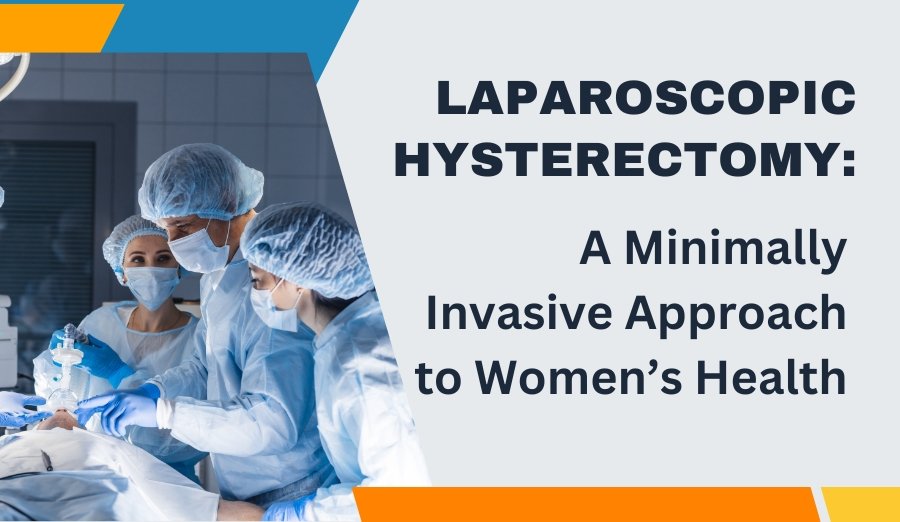-
Ganesh Talkies, Kolkata
Ganesh Talkies, Kolkata

Hello reader!
Welcome to the blog page of Dr. Megha Khanna, one of the best lady gynecologist in Kolkata.
Women’s health has seen remarkable advancements over the years, and one such breakthrough is the development of laparoscopic hysterectomy. This minimally invasive surgical procedure has revolutionized how gynecological issues are addressed, offering women a safer, quicker, and more comfortable alternative to traditional surgery. As one of the best lady gynecologist in Kolkata, Dr. Megha Khanna is committed to helping women understand this procedure and its benefits for their overall well-being.

A laparoscopic hysterectomy is a surgical procedure to remove the uterus using small incisions and a specialized camera called a laparoscope. Unlike traditional open surgery, which requires a large incision, laparoscopic surgery is performed through small incisions in the abdomen, resulting in less pain and a faster recovery.
This procedure is commonly recommended for conditions like:
As one of the best lady gynecologist in Kolkata, I emphasize educating my patients about the procedure to help them make informed decisions.
Laparoscopic hysterectomy is a minimally invasive surgical procedure to remove the uterus, and while it offers several benefits over traditional methods, it is not without potential risks. Understanding these risks is crucial for patients considering this procedure. Here are the main risks associated with laparoscopic hysterectomy:
As with any surgery requiring anesthesia, there are inherent risks involved, including allergic reactions, respiratory complications, and cardiovascular issues. Anesthesia-related complications are generally rare but can be serious.
Heavy bleeding during or after the procedure can occur, requiring blood transfusions in some cases. While laparoscopic techniques typically result in less blood loss than traditional open surgery, the risk still exists.
During laparoscopic hysterectomy, there is a risk of injuring nearby organs, such as the bladder, ureters (the tubes connecting the kidneys to the bladder), or bowel. Such injuries may necessitate additional surgical intervention to repair.
Infections can occur at the incision sites or internally. Although the risk of infection is lower with laparoscopic procedures compared to open surgeries, it remains a possibility that requires monitoring post-surgery.
Some women may experience complications related to vaginal health following a laparoscopic hysterectomy. These can include vaginal prolapse (where part of the vagina protrudes outside the body) or vaginal fistulas (abnormal connections between the vagina and other organs).
If the ovaries are removed during the procedure (oophorectomy), patients will enter menopause immediately if they have not already done so naturally. This can lead to menopausal symptoms such as hot flashes, mood swings, and vaginal dryness.
Although many patients report reduced pain after surgery, some may experience chronic pelvic pain as a complication of the procedure. This pain can affect quality of life and may require further evaluation and treatment.
There is a risk of developing blood clots in the legs (deep vein thrombosis) that can travel to the lungs (pulmonary embolism). This risk is generally low but can be serious; preventive measures such as early mobilization and compression stockings are often recommended.
Scar tissue formation (adhesions) can occur after any abdominal surgery, including laparoscopic hysterectomy. These adhesions may lead to complications in future surgeries or cause bowel obstructions.

The procedure involves the following steps:
Thanks to the precision of laparoscopic techniques, the surgery minimizes tissue damage and promotes quicker healing.
Also Read: Laparoscopic or Abdominal Hysterectomy: Which Is Right for You?
Being one of the best lady gynecologist in Kolkata, I ensure my patients receive personalized care and guidance throughout their journey, from diagnosis to recovery.

While the procedure offers numerous benefits, not all patients are suitable candidates. Factors such as medical history, the severity of the condition, and overall health are considered. It’s crucial to consult a skilled gynecologist who can evaluate your case and recommend the best approach.
As one of the best lady gynecologists in Kolkata, I work closely with my patients to determine the most appropriate treatment for their unique needs.
Before undergoing a laparoscopic hysterectomy, patients should:
Clear communication between the patient and the gynecologist is vital for a smooth surgical experience.
Post-surgery, patients can expect mild discomfort and may need a few weeks to fully recover. Here are some aftercare tips:
Patients treated by one of the best lady gynecologist in Kolkata can feel confident knowing they are in capable hands throughout the recovery process.

Choosing a laparoscopic hysterectomy over traditional methods offers numerous advantages that can significantly enhance patient outcomes. Here are the main benefits of opting for this minimally invasive approach:
One of the most notable advantages of laparoscopic hysterectomy is the use of smaller incisions compared to traditional open surgery, which requires a large abdominal incision. Typically, laparoscopic procedures involve several small incisions (usually less than one centimeter) made in the abdomen. This results in less tissue trauma, reduced scarring, and a more cosmetically appealing outcome for the patient.
Patients undergoing laparoscopic hysterectomy generally experience less postoperative pain than those who have traditional open surgery. The smaller incisions and reduced tissue trauma contribute to a more comfortable recovery process, allowing patients to manage their pain with milder medications instead of strong pain relievers. This reduction in pain can lead to improved overall patient satisfaction.
Laparoscopic hysterectomy typically requires a shorter hospital stay compared to open surgery. Most patients can expect to be discharged within 24 to 48 hours after the procedure, while traditional methods may necessitate a hospital stay of several days. This quicker discharge allows patients to return to the comfort of their homes sooner, facilitating a smoother recovery process.
The recovery time associated with laparoscopic hysterectomy is significantly shorter than that of traditional hysterectomy procedures. While full recovery from an open hysterectomy can take four to six weeks, many women find they can resume light activities within just a few days after laparoscopic surgery. The overall faster recovery is due to less pain, smaller incisions, and reduced risk of complications.
Laparoscopic hysterectomy is associated with a lower risk of complications such as infections and blood loss. The minimally invasive nature of the procedure means that there is less disruption to the body’s tissues, leading to fewer postoperative issues. This aspect is particularly beneficial for patients with higher body mass indexes (BMIs), as they often face increased risks during surgical procedures.
The use of a laparoscope—a thin tube with a camera—provides surgeons with enhanced visualization of the pelvic organs during the procedure. This allows for greater precision and accuracy in performing the surgery and enables the surgeon to identify and address any other pathologies present at the same time. This capability is especially useful for patients with conditions like endometriosis or adhesions from previous surgeries.
The smaller incisions used in laparoscopic hysterectomy result in minimal scarring compared to traditional methods, which often leave larger scars on the abdomen. For many patients, this cosmetic advantage is an important consideration when choosing their surgical options.
While costs can vary depending on specific circumstances and healthcare facilities, laparoscopic hysterectomy is often less expensive overall than traditional open surgery due to shorter hospital stays and reduced need for pain management and postoperative care. The efficiency of laparoscopic procedures can lead to lower healthcare costs for both patients and providers.

A laparoscopic hysterectomy significantly impacts recovery time compared to traditional open surgery methods. Here are the key aspects of how this minimally invasive approach affects recovery:
Patients undergoing laparoscopic hysterectomy typically experience a much shorter hospital stay. Most women are discharged within 24 to 48 hours after the procedure, depending on their individual recovery progress and the surgeon’s recommendations. In contrast, traditional open hysterectomy patients may require a hospital stay of several days to a week due to the larger incisions and greater tissue trauma involved in that method.
One of the significant advantages of laparoscopic hysterectomy is the reduction in postoperative pain. The smaller incisions and less invasive nature of the procedure lead to less tissue damage, resulting in lower pain levels post-surgery. Many patients find that they can manage their pain with milder medications rather than strong narcotics, which contributes to a quicker recovery.
Patients who undergo laparoscopic hysterectomy can often resume light activities within just a few days to a week after surgery. While individual recovery times vary based on factors such as overall health and the extent of the surgery, most women can return to normal routines relatively quickly. Full recovery typically takes several weeks, during which patients are advised to avoid heavy lifting and strenuous exercise.
The minimally invasive nature of laparoscopic surgery reduces the risk of complications such as infections and blood loss. This lower risk contributes to a smoother recovery process, allowing patients to regain mobility more quickly and reducing the chances of postoperative complications that can prolong recovery time.
While most patients can return to light activities soon after surgery, full recovery may take four to six weeks. During this time, patients are encouraged to gradually increase their activity levels as tolerated. Light walking is often recommended shortly after surgery to promote circulation and healing, while more strenuous activities should be avoided until cleared by a healthcare provider.

The full benefits of a laparoscopic hysterectomy typically manifest over several weeks to a few months following the procedure. Here’s a breakdown of what to expect regarding recovery and the timeline for experiencing the complete advantages of this minimally invasive surgery:
As one of the best lady gynecologists in Kolkata, I bring years of expertise in minimally invasive gynecological surgeries. My approach is centered on patient comfort, safety, and education, ensuring every woman feels empowered about her health choices.

1. What is a laparoscopic hysterectomy?
A laparoscopic hysterectomy is a minimally invasive surgery to remove the uterus using small incisions and a camera-guided instrument called a laparoscope.
2. What conditions can be treated with laparoscopic hysterectomy?
It is commonly used for uterine fibroids, endometriosis, abnormal bleeding, pelvic pain, uterine prolapse, and some cancers.
3. What are the benefits of laparoscopic hysterectomy compared to traditional surgery?
The procedure involves smaller incisions, less pain, shorter hospital stays, faster recovery, and minimal scarring.
4. How long is the recovery period after laparoscopic hysterectomy?
Most patients recover in 2–4 weeks, significantly faster than the recovery period for open surgery.
5. Who is a good candidate for laparoscopic hysterectomy?
Candidates are typically those with non-complicated gynecological conditions and good overall health. Consult a gynecologist to determine suitability.
A laparoscopic hysterectomy is a groundbreaking solution for women facing complex gynecological issues. Its minimally invasive nature, faster recovery, and excellent outcomes make it a preferred choice for many.
If you’re considering a laparoscopic hysterectomy or have questions about your gynecological health, don’t hesitate to consult one of the best lady gynecologist in Kolkata, Dr. Megha Khanna. Together, we can work towards ensuring your health and well-being for a brighter future.